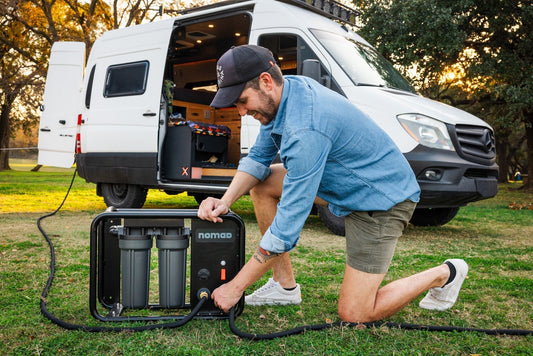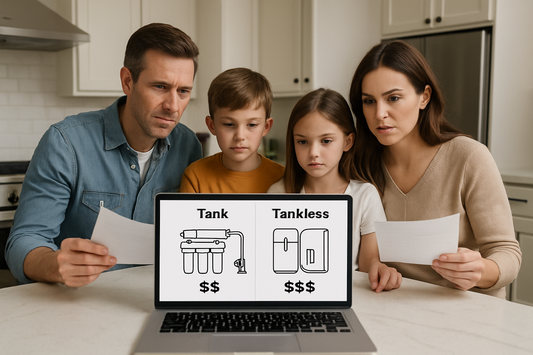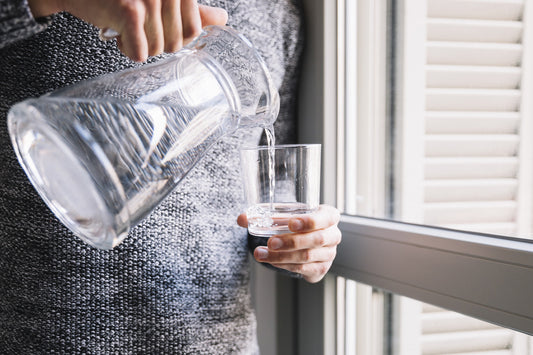Clean, safe drinking water shouldn't be a luxury in your own kitchen. If you're tired of chlorine taste, worried about contaminants, or constantly buying bottled water, an under sink water filter offers a practical solution that works behind the scenes.
These compact filtration systems connect directly to your water supply line, transforming ordinary tap water into clean, great-tasting water every time you turn on the faucet. Unlike bulky countertop units, under sink water filters stay hidden beneath your kitchen sink while delivering continuous filtered water for drinking, cooking, and food preparation.
What Are Under Sink Water Filters?
Under sink water filters are point-of-use filtration systems installed beneath your kitchen sink, connected directly to your cold water supply line. These systems filter water at the source before it reaches your faucet, removing contaminants like chlorine, lead, sediment, and bacteria that can affect taste, odor, and safety.
The key advantage lies in their strategic placement. By filtering water right before use, these systems ensure maximum freshness while maintaining your kitchen's clean appearance. Most models fit easily in standard cabinet spaces and work with existing plumbing connections.
Types of Under Sink Water Filters: A Decision Framework
Basic Single-Stage Filters
Best for: Light filtration needs, budget-conscious households
Removes: Chlorine, basic sediment, some taste and odor issues
Price range: $50-$150
Filter lifespan: 3-6 months
These straightforward systems connect directly to your existing faucet line. They're the most affordable option and easiest to install, making them ideal for renters or those with minimal water quality concerns.
Multi-Stage Carbon Filters
Best for: Comprehensive contaminant removal, families prioritizing taste
Removes: Chlorine, lead, pesticides, volatile organic compounds (VOCs)
Price range: $150-$400
Filter lifespan: 6-12 months
Multi-stage systems use activated carbon and additional filtration media to tackle a broader range of contaminants. They often include a separate filtered water faucet, preserving your main tap for unfiltered water when needed.
Reverse Osmosis (RO) Systems
Best for: Maximum purification, areas with heavy contamination
Removes: 95-99% of dissolved solids, including fluoride, arsenic, nitrates
Price range: $200-$600
Filter lifespan: 6-24 months (varies by stage)
RO systems provide the most thorough filtration available, forcing water through a semi-permeable membrane that removes even microscopic contaminants. They typically include a storage tank and dedicated faucet.

Image by hryshchyshen
How to Install Water Filter Under Sink: Step-by-Step Process
Installing most under sink water filters requires basic DIY skills and common tools. Here's the general process:
Before You Start:
- Turn off water supply at the shut-off valve
- Clear cabinet space beneath the sink
- Gather tools: adjustable wrench, drill (if needed), Teflon tape
Installation Steps:
- Mount the filter housing to the cabinet wall using provided brackets
- Connect to cold water line using the included T-connector or saddle valve
- Install filtered water faucet (if separate faucet required)
- Test all connections for leaks before use
- Flush system according to manufacturer instructions
Most installations take 1-2 hours. While many homeowners can handle this project, consider professional installation for complex RO systems or if you're uncomfortable working with plumbing connections.
Crystal Quest Under Sink Systems: Performance Highlights
Crystal Quest under sink water filters offer reliable filtration technology designed for long-term performance. Their multi-stage systems combine activated carbon with specialized media to target specific contaminants while maintaining healthy mineral content.
Key features include:
- Multi-stage filtration removing chlorine, lead, and organic compounds
- Easy cartridge replacement with color-coded filter housings
- Compact design fitting most cabinet configurations
- NSF-certified components ensuring reliable contaminant removal
These systems work particularly well for households wanting comprehensive filtration without the complexity of reverse osmosis.
Maintenance: Keeping Your System Running Efficiently
Proper maintenance ensures optimal performance and extends your investment. Here's what to expect:
Filter Replacement Schedule:
- Single-stage filters: Every 3-6 months
- Multi-stage carbon filters: Every 6-12 months
- RO membranes: Every 18-24 months
Signs It's Time to Replace:
- Decreased water flow rate
- Return of chlorine taste or odor
- Visible sediment in filtered water
- Manufacturer's recommended timeline reached
Quick Maintenance Tips:
- Mark replacement dates on your calendar
- Keep spare filters on hand
- Check for leaks during routine kitchen cleaning
- Monitor water pressure changes

Image by hryshchyshen
Choosing the Right Water Filtration System for Kitchen Sink
Consider these factors when selecting your under sink filter:
Water Quality Testing: Start with a water test to identify specific contaminants in your supply. This determines which filtration technology you actually need.
Installation Space: Measure your under-sink cabinet space. RO systems require more room for storage tanks, while single-stage filters need minimal space.
Water Usage: Large families benefit from higher-capacity systems or faster flow rates. Consider daily filtered water consumption for drinking and cooking.
Budget Considerations: Factor in both initial cost and ongoing filter replacement expenses. Sometimes spending more upfront saves money long-term through longer-lasting filters.
Troubleshooting Common Issues
Slow Water Flow: Replace clogged filters or check for kinked tubing. RO systems naturally have slower flow due to the filtration process.
Leaks at Connections: Tighten fittings with an adjustable wrench. If leaks persist, replace O-rings or contact manufacturer support.
Strange Taste or Odor: Usually indicates filter saturation. Replace cartridges even if timeline hasn't been reached if water quality changes.
Environmental Impact and Cost Savings
Under sink water filters significantly reduce plastic bottle waste while providing cost-effective clean water. A typical system pays for itself within 6-12 months compared to buying bottled water, then continues saving money for years.
Proper filter disposal matters too. Many manufacturers offer recycling programs for used cartridges, and some components can be recycled through standard municipal programs.
People Also Ask
How long do under sink water filters last? Filter cartridges typically last 3-12 months depending on water quality and usage, while the system housing can function for 5-10 years with proper maintenance.
Can I install an under sink water filter myself? Most homeowners can install basic systems with standard tools, though complex RO systems may benefit from professional installation to ensure proper operation.
Do under sink filters remove fluoride? Standard carbon filters don't remove fluoride, but reverse osmosis systems effectively eliminate 95%+ of fluoride along with other dissolved minerals.
What's the difference between under sink and countertop filters? Under sink filters stay hidden, offer higher capacity, and typically provide better filtration, while countertop models are portable but take up counter space.





